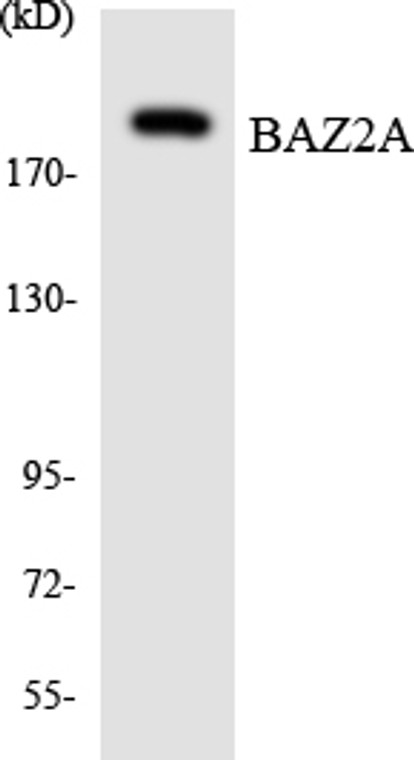| Host: |
Rabbit |
| Applications: |
WB/IHC |
| Reactivity: |
Human/Rat/Mouse |
| Note: |
STRICTLY FOR FURTHER SCIENTIFIC RESEARCH USE ONLY (RUO). MUST NOT TO BE USED IN DIAGNOSTIC OR THERAPEUTIC APPLICATIONS. |
| Short Description: |
Rabbit polyclonal antibody anti-Bromodomain adjacent to zinc finger domain protein 2A (1281-1330 aa) is suitable for use in Western Blot and Immunohistochemistry research applications. |
| Clonality: |
Polyclonal |
| Conjugation: |
Unconjugated |
| Isotype: |
IgG |
| Formulation: |
Liquid in PBS containing 50% Glycerol, 0.5% BSA and 0.02% Sodium Azide. |
| Purification: |
The antibody was affinity-purified from rabbit antiserum by affinity-chromatography using epitope-specific immunogen. |
| Concentration: |
1 mg/mL |
| Dilution Range: |
WB 1:500-2000IHC-P 1:50-300 |
| Storage Instruction: |
Store at-20°C for up to 1 year from the date of receipt, and avoid repeat freeze-thaw cycles. |
| Gene Symbol: |
BAZ2A |
| Gene ID: |
11176 |
| Uniprot ID: |
BAZ2A_HUMAN |
| Immunogen Region: |
1281-1330 aa |
| Specificity: |
Tip5 Polyclonal Antibody detects endogenous levels of Tip5 protein. |
| Immunogen: |
The antiserum was produced against synthesized peptide derived from the human BAZ2A at the amino acid range 1281-1330 |
| Post Translational Modifications | Acetylation at Lys-680 by KAT8/MOF promotes its dissociation from pRNA, affecting heterochromatin formation, nucleosome positioning and rDNA silencing. Deacetylation by SIRT1 in late S phase enhances pRNA-binding, allowing de novo DNA methylation and heterochromatin formation. Acetylation is high during S phase and declines to background levels in late S phase when the silent copies of rRNA genes are replicated. Ubiquitinated. Deubiquitinated by USP21 leading to its stabilization. |
| Function | Regulatory subunit of the ATP-dependent NoRC-1 and NoRC-5 ISWI chromatin remodeling complexes, which form ordered nucleosome arrays on chromatin and facilitate access to DNA during DNA-templated processes such as DNA replication, transcription, and repair. Both complexes regulate the spacing of nucleosomes along the chromatin and have the ability to slide mononucleosomes to the center of a DNA template. Directly stimulates the ATPase activity of SMARCA5 in the NoRC-5 ISWI chromatin remodeling complex. The NoRC-1 ISWI chromatin remodeling complex has a lower ATP hydrolysis rate than the NoRC-5 ISWI chromatin remodeling complex. Within the NoRC-5 ISWI chromatin remodeling complex, mediates silencing of a fraction of rDNA by recruiting histone-modifying enzymes and DNA methyltransferases, leading to heterochromatin formation and transcriptional silencing. In the complex, it plays a central role by being recruited to rDNA and by targeting chromatin modifying enzymes such as HDAC1, leading to repress RNA polymerase I transcription. Recruited to rDNA via its interaction with TTF1 and its ability to recognize and bind histone H4 acetylated on 'Lys-16' (H4K16ac), leading to deacetylation of H4K5ac, H4K8ac, H4K12ac but not H4K16ac. Specifically binds pRNAs, 150-250 nucleotide RNAs that are complementary in sequence to the rDNA promoter.pRNA-binding is required for heterochromatin formation and rDNA silencing. |
| Protein Name | Bromodomain Adjacent To Zinc Finger Domain Protein 2aTranscription Termination Factor I-Interacting Protein 5Ttf-I-Interacting Protein 5Tip5Hwalp3 |
| Database Links | Reactome: R-HSA-427413 |
| Cellular Localisation | NucleusNucleolusColocalizes With The Basal Rna Polymerase I Transcription Factor Ubf In The Nucleolus |
| Alternative Antibody Names | Anti-Bromodomain Adjacent To Zinc Finger Domain Protein 2a antibodyAnti-Transcription Termination Factor I-Interacting Protein 5 antibodyAnti-Ttf-I-Interacting Protein 5 antibodyAnti-Tip5 antibodyAnti-Hwalp3 antibodyAnti-BAZ2A antibodyAnti-KIAA0314 antibodyAnti-TIP5 antibody |
Information sourced from Uniprot.org
12 months for antibodies. 6 months for ELISA Kits. Please see website T&Cs for further guidance







